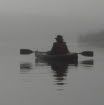A couple of days ago, walking from the garden toward the house in that peculiar dazed state as my back slowly straightened out and my awareness slowly broadened from task to surroundings, I halted and stared after an unmistakable pattern of black and orange. A redstart had just flitted across my yard.
I never would have expected to see one here in town. North in the hills, certainly, but here? There are plenty of hedgerows, but no big patches of bush. My guess is that he was just taking a little side tour while passing through.
Later, back at the digging, I listened to the background birdsong and noticed how it had changed since I first started my digging project. Meadowlarks, red-winged blackbirds, and robins have been joined by numerous goldfinches with their bright rising whistles and the exuberant-sounding "dip-dip-dip" of their flight song. I heard a sharp "Che-BEK! Che-BEK!" and thought, "Ah, a least flycatcher." But I also heard the clear whistled melody of a white-throated sparrow and thought about how the chickadees had fooled me way back in March. I don't know if there was an influx of chickadees, or if they switched from "dee-dee-dee" to their whistled song, or if I just suddenly started listening, but I thought I was hearing white-throated sparrows. This week I'm hearing the real thing and feeling a bit silly.
The reminder of my folly will soon pass, as the sparrows move on toward the edge of the boreal forest.
I continued to listen, and slowly some of the chorus resolved into two separate familiar songs: common yellowthroat and yellow warbler. That would make sense, in our small-town mosaic of lawns and trees and hedges. Still, mistrustful of my ear, I listened very intently, trying to bring to mind a clear recollection of the songs I knew, and at the same time to hear openly without the distortion of expectations.
One voice was very close. In fact, it came from the branches of the Manitoba maple directly behind me. What were the chances I could get a glimpse? Well, it couldn't hurt to try. I set down the shovel and walked toward the tree, not troubling too much about moving slowly or quietly or circuitously. The song stopped, but I saw a flicker of movement. A few more steps, and a little more movement among the leaves above, and there it was. Its striking black mask and bright yellow throat were familiar from fieldguide pictures, but as far as I can recall, I had never actually seen one before; I knew it only by its voice. And I knew it correctly, as the common yellowthroat.
Reassured, I went back to my shovel.
Subscribe to:
Post Comments (Atom)





1 comment:
Yellowthroats make themselves very hard to see, but you're right - you need only know their song.
Post a Comment